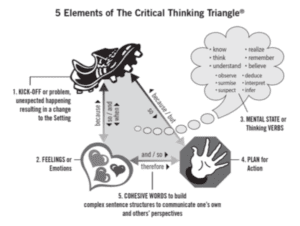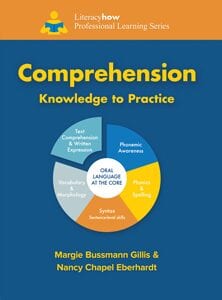
April 2020
In the last issue, we discussed the value of oral storytelling. Here we delve into the importance of explicitly teaching the text structure of narratives as one means of facilitating students’ comprehension.
Text structure, one of the five big ideas discussed in Comprehension: Knowledge to Practice, refers to how a text is organized. This organization guides the reader’s—or listener’s—comprehension by enabling them to recognize relationships among structural elements in the text. Recognition of these elements helps readers form a mental model of the story so they can attend to salient text details, thereby increasing comprehension.
As discussed in our book, it is important to teach both narrative and informational text structures. Even with a shift in emphasis in the Common Core State Standards to the use of nonfiction texts to develop students’ background knowledge, teachers should not overlook the value of narratives.
Whatever our age, we can be changed by the lives of others if we learn to connect the whole of the reading circuit with our moral imagination.
In The Science and Poetry in Learning (and Teaching) to Read, Maryanne Wolf makes the case for teaching narratives: “Stories are one of humanity’s most powerful vehicles for making lasting connections to people we will never meet. To feel like Charlotte about Wilbur’s plight in Charlotte’s Web, to identify with Martin Luther King Jr. in Martin’s Big Words: The Life of Dr. Martin Luther King Jr. or with Ruby Bridges in Through My Eyes prepares children to empathize both with their neighbors and with people around the world or across the proverbial railroad tracks … Whatever our age, we can be changed by the lives of others if we learn to connect the whole of the reading circuit with our moral imagination.”
The Role of Interactive Read Alouds
Before students even begin to acquire the alphabetic principle, they largely focus on meaning through oral language, i.e., speaking and listening. Teachers can—and should—use listening-level text for read alouds to develop the language processing abilities that underpin all of the comprehension big ideas. This practice addresses one of the criticisms of a “balanced literacy” approach, namely that it confines students to “leveled” or “just right” text, depriving them of the growth opportunities more difficult texts would confer.
Decades of research “confirm that listening comprehension outpaces reading comprehension from early childhood through at least middle school” (Fisher and Frey, 2014). This fact supports using listening-level text as part of a comprehensive plan, not only with beginning readers, but also through intermediate and middle school years.
Read alouds should be interactive, with the teacher (or parent) and student actively thinking about and discussing the story. For example, parents can ask their children about the setting (where and when the story took place), the characters (the people, animals, or creatures who act out the events), the problem (what happened to set the story in motion), and the solution (how the problem turned out). Teachers can explore our book to learn how to plan effective, purposeful read alouds around carefully selected text.
Teaching Story Grammar
Moreau provides a student-friendly Critical Thinking Triangle (CTT) model—depicted below—to support students in their understanding of the dynamics that drive a narrative. The CTT incorporates the three important elements of story grammar—the initiating event, the internal responses or feelings, and the plan for action. Understanding these elements is what helps build our moral imagination as Wolf described above. The CTT model also includes two additional elements: the mental state of thinking verbs and cohesive words that connect the three components of the triangle. Teachers can use the five parts of the CTT to explicitly teach students to express orally their understandings of stories that they read or listen to. A Story Map can serve as a graphic organizer to aid in this process.

Drymock (2007) points out, “Story grammars are rather like the set of grammatical rules that are used to structure sentences … Story grammar research moves the teacher away from general explanations of story structure (e.g., that stories have a beginning, middle, end) to the more specific (e.g., that stories have characters, a theme, and a plot.)” These more specific story grammar elements are a scaffold, facilitating understanding and recall.
Teachers can turn to our book to learn more about narrative and informational text structures.
